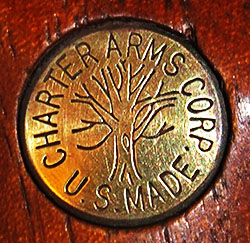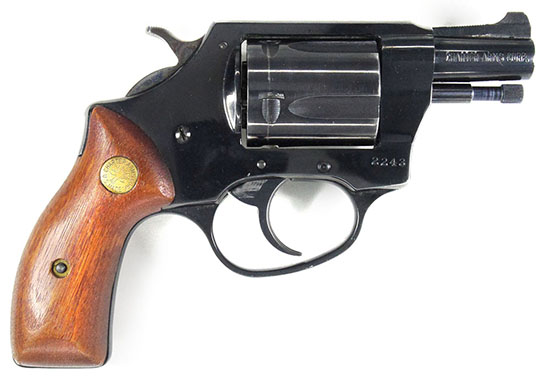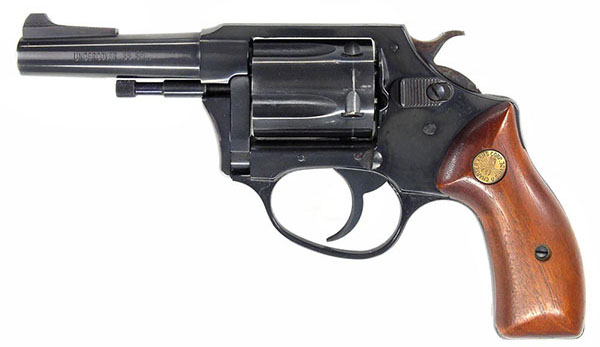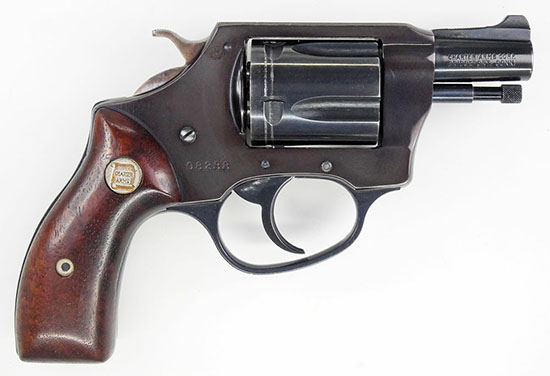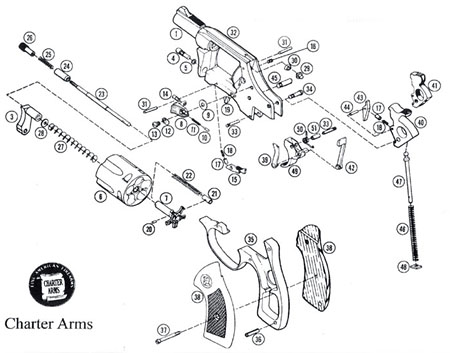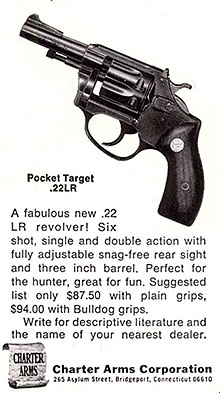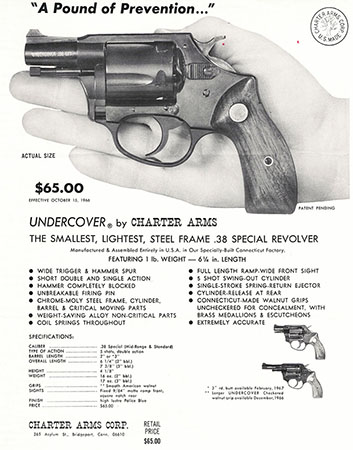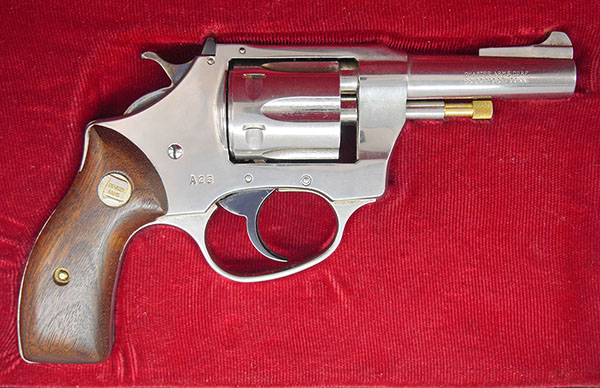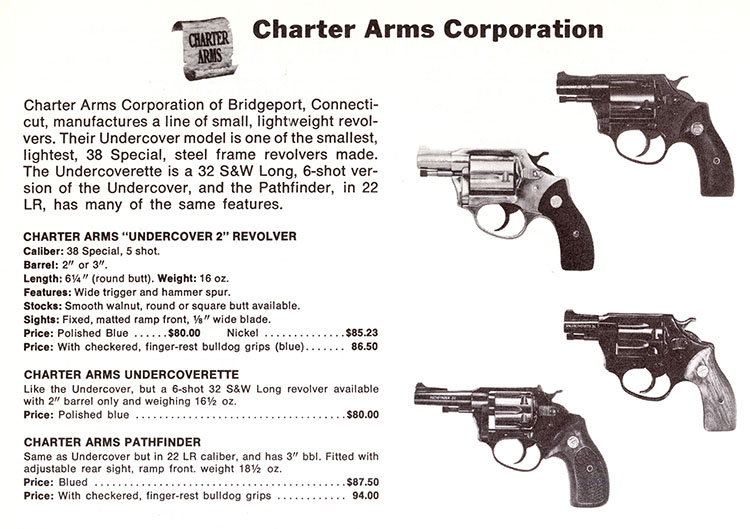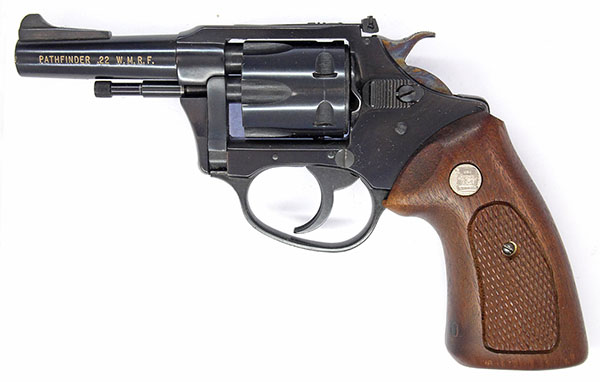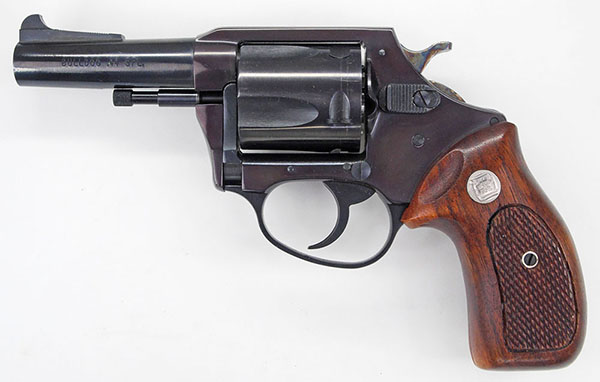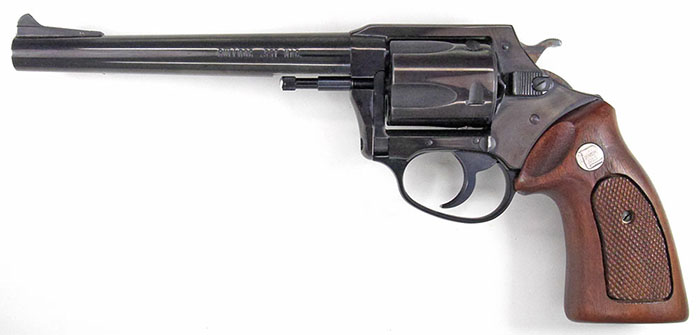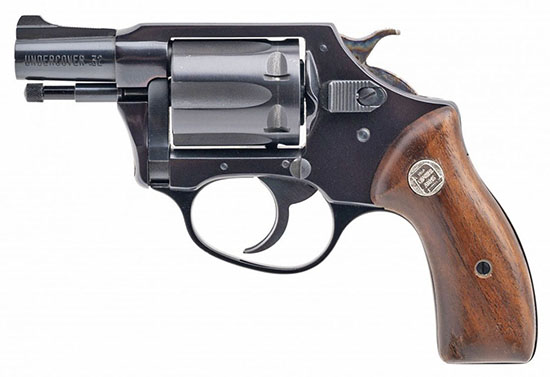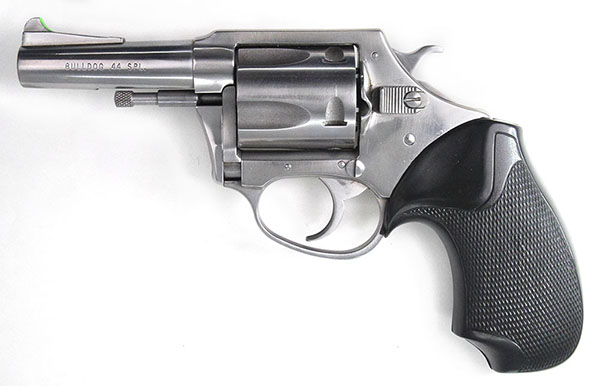 |
||||||||||||||||||||||||||||||||||||||||||||||||||||||||||||||||||||||||||||||||||||||||||||||||||||||||||||||||||||||||||||||||||||||||||||||||||||||||||||||||||||||||||||||||||||||||||||||||||||||||||||||||||||||||||||||||||||||||||||||||||||||||||||||||||||||||||||||||||||||||
|
Charter Arms Revolvers by Ed Buffaloe |
||||||||||||||||||||||||||||||||||||||||||||||||||||||||||||||||||||||||||||||||||||||||||||||||||||||||||||||||||||||||||||||||||||||||||||||||||||||||||||||||||||||||||||||||||||||||||||||||||||||||||||||||||||||||||||||||||||||||||||||||||||||||||||||||||||||||||||||||||||||||
Company History The Charter Arms Corporation was founded in 1964 by Doug McClenahan. According to the current company website (in 2013): “For years Doug McClenahan was a gun designer with several prominent American gun companies [Colt, High Standard, and Sturm Ruger]. Using his strong engineering and inventive background he decided to start his own company and in 1964 he founded Charter Arms. McClenahan and David Ecker were lifelong friends and in 1967 Ecker became a 50/50 partner in Charter Arms.” By 1970 Ecker was assistant manager for marketing and sales. The company went through several name and address changes. The early revolvers (the first 13500 or so, which can be referred to as the first generation), did not display an address on the right side of the barrel, being marked only in capital sans-serif characters: CHARTER ARMS CORP.
Early Charter Arms revolvers had a brass grip medallion with a sketch of an oak tree circled by the words CHARTER ARMS CORP. U.S. MADE (at least through serial number 23825). The serial number was at the front of the frame, on the right side. The grip medallion was later changed to a scroll with the words “Charter Arms” on it, and “USA” in tiny letters at the top; these later medallions were made of brass plated with nickel. The serial number was moved to the rear of the frame, on the right side, somewhere between serial number 23563 and 249134. Starting in 1966, the revolvers were marked on the right side of the barrel in all capital sans-serif characters: CHARTER ARMS CORP.
Doug McClenahan moved the company to a newly-built plant in Stratford, Connecticut in April of 1976. Revolvers made in Stratford were marked on the right side of the barrel: CHARTER ARMS CORP. On 15 December 1978, due to health problems, Doug McClenahan retired and sold his share of the company to his partner, Dave Ecker. Ecker assumed the position of Chairman of the Board as well as President. In 1984 Nick Ecker, Dave Ecker’s son, became part owner. Around 1988 the company was acquired by its vice president of finance, Jeff Williams, renamed Charco, and moved to Ansonia, Connecticut. At some later time, Nick Ecker reacquired a 20% stake in the company. Apparently, quality control was not good in Charco, and the company had to close its doors in 1998. Nick Ecker and two other investors bought the company and reopened it in 2000, under the name Charter 2000, and relocated to Shelton, Connecticut. By 2002 Ecker had become sole owner, and in 2007 he renamed the company Charter Arms again. The guns made since 2000 have had good quality control, and the company has regained its earlier reputation for quality and reliability. Design of the Charter Arms Revolver The Charter Arms revolver utilizes an investment-cast one-piece frame with no side plate. This means that it can be made lighter than a frame with a side plate and still retain the strength necessary to withstand relatively powerful ammunition (an early instruction book states that use of other than standard velocity ammunition will void the warranty, but the more modern guns are rated for +P). The trigger guard and grip frame are a separate piece made of aluminum alloy to save weight. The ejector rod is also aluminum. All other parts on the original Undercover revolver are made of steel. The Undercover is virtually identical in size and looks to the Smith & Wesson snubnose .38 (Model 36 or 37), but the cylinder turns to the right (clockwise) instead of to the left.
The current (2013) Charter Arms website states that the Charter Undercover revolver was “the smallest, lightest steel framed revolver in the world with the fewest moving parts. A unique hammer block system gave gun owners unparalleled protection against unintentional discharge.” Despite the fact that the part is labeled a “hammer block,” it is essentially a transfer bar that moves into position when the trigger is all the way to the rear and allows the hammer to connect with the firing pin. The gun has a beryllium-copper firing pin that is nearly indestructable. Robert Dunlop, master gunsmith, says he has only ever seen one broken firing pin in a Charter Arms revolver. From the first gun made, the Charter Arms Undercover revolver featured button rifling with eight grooves.
Timetable of Charter Arms Products and Features Extrapolating from the data given further down on this page, taken from back issues of Gun Digest and a few old catalogs, the likely initial production years of the various Charter Arms guns and their features is as follows:*
History and Evolution of the Charter Arms Revolver Line The Charter Arms revolver was first listed in Gun Digest for 1965 (please note that Gun Digest is written and copyrighted the year before the date on the cover). I will quote the two short paragraphs: New on the market this year are two 38 Special revolvers produced by Charter Arms Corp., 980 Mill Hill Rd., Southport, Conn. The Undercover 2 is a 5-shot 16 oz. double action with a 2” bbl. The Undercover 3 weighs 17½ oz. with a 3” bbl. Either can be had with interchangeable round or square butt smooth walnut grips. Features include chrome-moly frames and swing-out cylinders; single-stroke ejection, wide trigger and hammer spur. Built-in hammer block prevents accidental discharge. Sights are fixed with a 1\8” ramp front and square notch rear. In polished blue, prices are the same for both models—$55. T
The 1966 issue of Gun Digest (written in 1965) says, “...as far as we can learn, production of these Charter Arms guns has been practically nothing... They may not be around for some months...” The guns were, in fact, available in 1965, but in very limited quantities. Finally, in the 1967 issue the editor notes that he saw and fired an Undercover at an NRA meeting in April 1966. He reveals that the one-piece frame of the gun is made of chrome-moly steel, while the trigger guard/grip frame is made of lightweight alloy. The gun also features 8-groove rifling and a 55° hammer throw arc. The 1969 issue of Gun Digest reports that the company’s only product remained the Undercover revolver, but they were offering a leather belt holster for the gun and custom engraving by the A.A. White Company. They had also begun offering an oversize “Bulldog” grip in checkered American Walnut. In this period the company changed its logo from an oak tree, based on Connecticut’s “Charter Oak,” to a parchment scroll with “Charter Arms” in antique lettering. The 1970 issue of Gun Digest reproduces a picture of a cutaway Charter Arms revolver and points out various improvements the company had made, including improved polishing for better blueing; a spring loaded cylinder latch; a redesigned ejector return spring, washer, and bushing for smooth-stroke ejection; a nylon washer under the crane screw; a simplified trigger system for better reliability; a fire-hardened breech face; London oil finished walnut grips; and 8- groove rifling with a 1:17” twist. Clearly, the company was continuing to improve its lone product.
The 1971 issue of Gun Digest lists a second Charter Arms product for the first time: the .22 Pocket -Target revolver (later known as the Pathfinder). The gun is built on the same frame as the Undercover; it has a shortened cylinder, a 3 inch barrel, and an adjustable rear sight. Only minor changes to the machining of the frame were necessary to produce the .22 pistol—the top of the frame is milled differently to accept the adjustable sight, and the position of the firing pin is slightly higher. Lockwork parts are identical to those in the Undercover. The Pocket-Target .22 is scarce. Some were made in a nickel finish and marked on the backstrap “1965 - FIFTH ANNIVERSARY CHARTER ARMS CORP - 1970.” The name of the Pocket-Target was changed almost immediately to Pathfinder, as even the late Fifth Anniversary guns are marked Pathfinder (beginning at least by SN A115). The Undercover is listed as available in a nickel finish for the first time, and the Undercoverette was introduced as a 6-shot, in .32 S&W Long.
The 1972 issue of Gun Digest lists the same gun as the .22 Pocket-Target, but it has been renamed the Pathfinder. A version was available with two cylinders, one in .22 Winchester Rimfire Magnum , known as the Dual Pathfinder. I do not know how long the Dual Pathfinder was manufactured, nor have I ever seen one. A third product was introduced for the first time: the Undercoverette, a 6-shot revolver in .32 Smith & Wesson Long, built on the Undercover frame and with a 2 inch barrel.
Apparently, Doug McLennahan had been planning a .44 Special version of his revolver from the very beginning of the business. In the Guns Annual Book of Handguns for Summer 1974, Mason Williams writes: “Quite a few years ago, when Doug McClenahan [sic] and his cohorts from Charter Arms would come over to my ranges to fire and test and discuss the then-new .38 special Undercover revolver, Doug would continually bug me about ideas and thoughts on a .44 caliber revolver. ... The years passed, and whenever I would meet Doug, I would ask about the .44. He had several serious accidents that delayed work on the new revolver, so that it was only recently that the .44 special Charter Arms revolver was ready.”
It is in the 1974 issue of Gun Digest that the Charter Arms .44 Bulldog first appears, and in the 1975 issue there is a lengthy article about it by George C. Nonte, Jr. The frame of the Charter Bulldog had to be beefed up to accommodate the more powerful cartridge, but even so, it is hard to tell the difference between the two guns when placed side-by-side. Nonte says: “Even though the cylinder and frame are substantially smaller than anything previously chambered for the .44 Special, their strength is more than adequate.” Robert Dunlop echoes this sentiment in his gunsmithing video, stating that the one-piece frames are quite strong. Many of the parts for the Bulldog are interchangeable with the Undercover, including the trigger, the hammer, and the cylinder latch mechanism. The 1976 issue of Gun Digest lists for the first time the Charter Arms Police Bulldog, which is a 6-shot 38 Special with a 4 inch barrel, a full-length ejector rod, an enclosed ejector housing, and an adjustable rear sight. The Undercover is offered in nickel.
The 1977 issue of Gun Digest lists a 5-shot Target Bulldog .357 Magnum revolver, featuring a 4-inch barrel, a full-length ejector rod, an enclosed ejector housing, square butt grips, and an adjustable rear sight, just like the Police Bulldog that appeared the year before. The barrel is a steel insert inside an aluminum shroud. Charter Arms was making use of its Bulldog frame to expand its offerings. The .44 Bulldog was offered in nickel for the first time. The 1979 issue of Gun Digest shows the Target Bulldog being offered in .44 Special for the first time, and either caliber is available in a 4 or 6 inch barrel. The regular Bulldog is now available in .357 with a 6 inch barrel. The Pathfinder is available with a 6 inch barrel and with optional square butt grips. The Undercoverette name has been dropped, but the Undercover is now available in .32 Smith & Wesson Long. The square butt grips can be had for the Undercover.
Also in 1979 the Mag-na-port company offered the Mag-na-port Backpacker in a limited edition of 250. These guns are in stainless steel and have a 1-7/8 inch Mag-na-ported bull barrel with no front sight, a factory bobbed spurless hammer, and Pachmayr grips. On the right side the barrel is marked CHARTER ARMS CORP. with no address, and on the left side it is marked .44 SPL. On the right side of the grip frame is engraved, on three lines, Mag-na-port / BACKPACKER / ###. 1981 was a signal year for Charter Arms. They announced several new products in 1980, which first appeared in 1981 or possibly as late as 1982. The 1981 issue of Gun Digest lists two guns in stainless steel for the first time: the Undercover (with a 2 inch barrel) and the Pathfinder (with a 3 inch barrel). Also, the Bulldog “Tracker” appeared for the first time: a .357 Bulldog with a 6 inch bull barrel, reported by Hal Swiggett as being 3/4 inch in diameter, giving the gun more heft. The Target Bulldog is only listed with a 4 inch barrel. In 1981 Charter Arms issued a pre-production stainless steel undercover, with special serial numbers in the PP### format, in a limited edition of 500. The 1982 issue of Gun Digest lists a 2 inch barrel for the Police Bulldog, as well as 4 inch bull barrel. The Bulldog is listed as available in stainless steel for the first time. The Police Bulldog is now available with a 4 inch bull barrel.
The 1983 issue of Gun Digest announced a new snubnose Police Bulldog in .38 Special with a 2 inch bull barrel, factory pocket hammer, and neoprene grips with finger grooves (looking very much like they were made by Pachmayr, though that isn’t stated). The Bulldog is also available for the first time with a pocket hammer and neoprene grips. The Tracker is listed with a 4 or a 6 inch bull barrel and an adjustable rear sight. In the 1984 issue of Gun Digest, the only thing new I can see is that the .357 Bulldog Tracker is now available in a 2½, 4, or 6 inch barrel. In the 1985 issue of Gun Digest the first Charter Arms revolver chambered for the (then) new H&R .32 Magnum round was announced: a 6 shot Undercover. In the back of the issue it is more correctly identified as the Police Undercover, available with a 2 or 4 inch barrel. All of the 2” barrel guns were called the Police Undercover instead of Police Bulldog which at this point were 4” barrel only. The .44 Bulldog is announced as available in either a 2½ or 3 inch barrel, with a full-length ramp front sight for the 2½ inch barrel with ejector shroud. Finally, the new Off Duty revolver was announced—as I see it, it was a no-frills 5 shot 38 revolver with a 2 inch barrel, nearly identical with the Undercover but with a cheaper finish. It was available in either matte black or stainless steel and had a red dot on the front sight. In the 1986 issue of Gun Digest the Police Bulldog is listed as available in 32 H&R Magnum for the first time. The Police Undercover is also still listed as available in 32 H&R Magnum, and now also available as a 6-shot .38 Special, with pocket hammer or spur hammer, in blue or stainless steel. The Off Duty is listed as available with neoprene grips. In the 1987 issue of Gun Digest the Bulldog Pug is available for the first time. The Pug is available only in blue with a 2½ inch barrel with a full ejector shroud and full-length ramp sight. The barrel is an assembly, with a cast aluminum exterior and a steel barrel sleeve. The Pug is available with factory pocket hammer and neoprene grips, or with spur hammer and walnut grips. I don’t find any new products in the 1988 issue of Gun Digest, but Hal Swiggett notes that Charter Arms had announced a new lifetime maintenance policy for original owners of Charter Arms guns—the warranty covered everything except the frame, barrel, and finish (which would leave little more than the cylinder and lockwork covered). Likewise I don’t see much new in the 1989 issue, but a catalog from this period shows a Bulldog Pug in stainless steel, and marks the introduction of “Select-A-Grips” which are wooden grips in various colors, including ebony, blonde, rosewood, camo, oak, burnt-orange, golden brown, aqua, and scarlet. In the 1990 issue of Gun Digest I note that the Police Undercover in 32 H&R Magnum has been dropped, and now they offer an Undercover Police Special (in .38 Special) with a 2.1” barrel, spurless hammer, full ejector rod shroud, and available in either blue or stainless steel. The “Bonnie” and “Clyde” revolvers were also announced. These are said to be similar to the Undercover Police Special, except they are available in blue only; one marked “Bonnie - .32 MAG”; the other one, marked “Clyde - .38 SPL”. They are available with Select-A-Grips. Charter Arms also introduced the Pit Bull, a 5-shot 9mm revolver with either a 2½” or 3½” barrel, in either blue or stainless steel. At this time, the Tracker appears to be only available with the 2½” bull barrel. The standard Bulldog has a 2½” bull barrel with no underlug.
|
||||||||||||||||||||||||||||||||||||||||||||||||||||||||||||||||||||||||||||||||||||||||||||||||||||||||||||||||||||||||||||||||||||||||||||||||||||||||||||||||||||||||||||||||||||||||||||||||||||||||||||||||||||||||||||||||||||||||||||||||||||||||||||||||||||||||||||||||||||||||
|
Copyright 2013-2025 by Ed Buffaloe. All rights reserved. |
||||||||||||||||||||||||||||||||||||||||||||||||||||||||||||||||||||||||||||||||||||||||||||||||||||||||||||||||||||||||||||||||||||||||||||||||||||||||||||||||||||||||||||||||||||||||||||||||||||||||||||||||||||||||||||||||||||||||||||||||||||||||||||||||||||||||||||||||||||||||
|
|
||||||||||||||||||||||||||||||||||||||||||||||||||||||||||||||||||||||||||||||||||||||||||||||||||||||||||||||||||||||||||||||||||||||||||||||||||||||||||||||||||||||||||||||||||||||||||||||||||||||||||||||||||||||||||||||||||||||||||||||||||||||||||||||||||||||||||||||||||||||||
